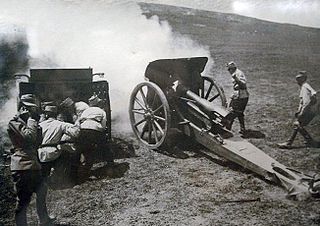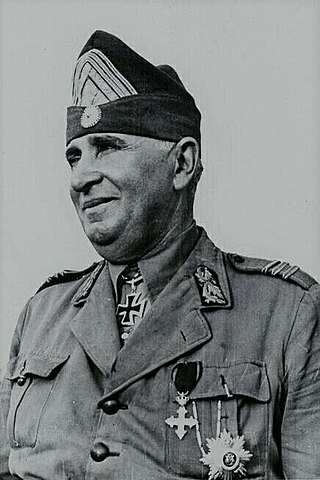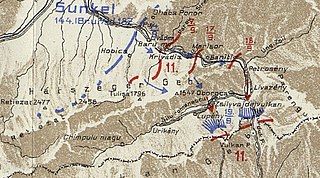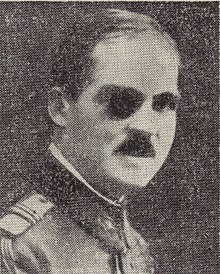
The Romanian Land Forces is the army of Romania, and the main component of the Romanian Armed Forces. Since 2007, full professionalization and a major equipment overhaul have transformed the nature of the Land Forces.

The 3rd Army was a field army of the Romanian Land Forces active from the 19th century to the 1990s. It fought as part of the German Army Group B during World War II, in Ukraine, the Crimea, and the Caucasus. General Petre Dumitrescu commanded the 3rd Army for much of that time.

The 2nd Infantry Brigade was a regional brigade of the British Army, active since before the First World War. It was the regional formation of the Army in the South East of England–the Brigade commanded and administered soldiers throughout Kent, Surrey and Sussex–but also Brunei. In December 2014 the Brigade merged with 145 (South) Brigade to form Headquarters 11th Infantry Brigade and Headquarters South East.
The 10th Infantry Brigade was a Regular Army infantry brigade of the British Army formed during the Second Boer War in 5th Division, and during both World Wars the brigade was part of the 4th Infantry Division.

The 29th Infantry Brigade was an infantry brigade unit of the British Army. It was originally raised in 1914 and saw service during the First and Second World Wars and the Korean War.

The Vânători de Munte are the elite mountain troops of the Romanian Land Forces. They were first established as an independent Army Corps in 1916 during World War I, and became operational in 1917 under Corpul de Munte designation.

The Battle of Mărăști was one of the main battles to take place on Romanian soil in World War I. It was fought between 22 July and 1 August 1917, and was an offensive operation of the Romanian and Russian armies intended to encircle and destroy the German 9th Army. The operation was planned to occur in tandem with the Nămoloasa offensive; however, this operation was abandoned before it began.

The Horea, Cloșca și Crișan Division was established in April 1945 from Romanian volunteers, mostly prisoners of war, but also Communist activists such as Valter Roman. It was created by the Soviet Union at Kotovsk, and named after the Revolt of Horea, Cloșca and Crișan.
The Fourth Army was a field army of the Romanian Land Forces active from the 19th century to the 1990s.

The 81st Mechanised Brigade is a mechanised brigade of the Romanian Land Forces, established on 1 March 1995. The unit's headquarters are in Bistrița, and it is subordinated to the 4th Infantry Division "Gemina", with headquarters in Cluj-Napoca. It is named after Grigore Bălan, a brigadier general in World War II, who was killed in action during the liberation of Transylvania in 1944.

Corneliu Dragalina was a Romanian lieutenant general during World War II.

Ioan Dumitrache was a Romanian major general during World War II, in command of the 2nd Mountain Division. His troops were recognized as the elite troops of the Romanian Army throughout the campaign on the Eastern Front. He was a recipient of the Knight's Cross of the Iron Cross of Nazi Germany, awarded to him for capturing Nalchik on November 2, 1942.

Ioan Mihail Racoviță was a Romanian general during World War II, and Minister of Defense in the aftermath of King Michael's Coup of August 1944.

Gheorghe Avramescu was a Romanian Lieutenant General during World War II. In 1945, he was arrested by the NKVD on the Slovakian front and died in custody the next day.
This is the order of battle for the First Battle of Târgu Frumos, a World War II Soviet offensive against Axis powers in Târgu Frumos, Romania.
The Axis order of battle at Stalingrad is a list of the significant land units that fought in the Battle of Stalingrad on the side of the Axis Powers between September 1942 and February 1943.

The Second Battle of Cobadin took place from 19 to 25 October 1916 between the Central Powers, chiefly the Bulgarian Third Army, and the Entente, represented by the Russo–Romanian Dobruja Army. The battle ended in a decisive victory for the Central Powers; it resulted in the occupation of the strategic port of Constanța and the capture of the railway between that city and Cernavodă.
Alecu Ioan Sion was a Romanian soldier and a major general in the Land Forces.

The First Battle of Petrozsény was a military engagement fought between Romanian forces on one side and German forces on the other side. It was part of the 1916 Battle of Transylvania, itself part of the Romanian Campaign of World War I. This was a German attack which drove off the Romanian forces from the Transylvanian coal mining center of Petrozsény. Although a Romanian counterattack a few days later undid most of their gains, the main strategic objective of the Central Powers had been nevertheless achieved.

Nicolae Macici was a Romanian lieutenant general during World War II, when he commanded the Romanian First Army, first on the side of the Axis (1941–1944) and then on the side of the Allies (1944–1945). Convicted in 1945 by the Bucharest People's Tribunal as a war criminal for his role in the Odessa massacre, he was sentenced to death, albeit his sentence was later commuted to life prison. Maici died at Aiud Prison five years later.
















